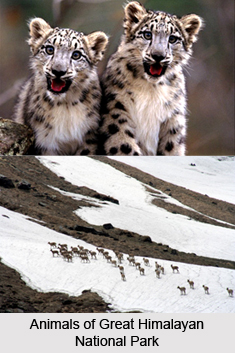 Great Himalayan National Park is a renowned one among various Indian national parks. The park is better known as the Jawaharlal Nehru Great Himalayan National Park. It was established in Kulu district in the year 1984. The lofty peaks of the Himalayas on three sides enclose it with an opening from the western side. The park covers an area of 620sq.km.of the Tirthan Sanctuary, set up in the previous century. The park lies in the Seraj Forest Division; The Sainj and theTirthan are two narrow rivers that have their origin in Himalayan massif and merge into the larger Beas River; about 50 km south of the renowned hill station of Kullu. Great Himalayan National Park constitutes the catchments forest of these two rivers and their adjoining tracts. It has an altitude ranging from 1500 to around 6000 meters with snow-clad mountains, glaciers, river valleys, cliffs and dense forest.
Great Himalayan National Park is a renowned one among various Indian national parks. The park is better known as the Jawaharlal Nehru Great Himalayan National Park. It was established in Kulu district in the year 1984. The lofty peaks of the Himalayas on three sides enclose it with an opening from the western side. The park covers an area of 620sq.km.of the Tirthan Sanctuary, set up in the previous century. The park lies in the Seraj Forest Division; The Sainj and theTirthan are two narrow rivers that have their origin in Himalayan massif and merge into the larger Beas River; about 50 km south of the renowned hill station of Kullu. Great Himalayan National Park constitutes the catchments forest of these two rivers and their adjoining tracts. It has an altitude ranging from 1500 to around 6000 meters with snow-clad mountains, glaciers, river valleys, cliffs and dense forest.
As per comprehensive wildlife surveys of the early 1970s , Great Himalayan National Park has been proved to be ideal abode of several endangered species in this area. Interestingly, it hosted five species of pheasants, including the vividly colored western tragopan and the Cheer Pheasant. They can be easily distinguished due to their huge, wide blocked tail and elongated crest.
Great Himalayan National Park has a plethora of green vegetation and beautiful flowers. The vegetation here ranges from deciduous forests of blue pine and cedar, oak and bamboo and grass meadows. The fauna constitute of wild mountain animals like the Himalayan thar, bharal, goral and serow, musk deer, leopard, brown and black bears, wolf, flying squirrel, langurs, rhesus macaques.
 Numerous birds are found in the Great Himalayan National Park numerous birds of Indian origin and also some special migratory birds are found in the park. Koklass, Cheer, Kalij, Himalayan Monal, Kalij Pheasant, Himalayan Snowcock, Hill Partridge, Yellow-billed Chough, Grandala, Spotted Nutcracker, Yellow-billed Blue Magpie. Grey Treepie, Large Hawk Cuckoo, Scaly-bellied Woodpecker, Great Barbet, Speckled Wood Pigeon, Striated Laughingthrush, Chestnut-bellied Rock Thrush, White-collared Blackbird, Plain Crossbill, Black-and-yellow GrosbeakHimalayan Monal and Western Tragopan are all found here, along with a variety of other forest birds. Among the hunting birds, Himalayan Griffon, Lammergcier, Golden Eagle, Booted Eagle, Common Kestrel, Oriental Hobby, Mountain Hawk Eagle, Collared Owlet, Tawny Owl are quite famous.
Numerous birds are found in the Great Himalayan National Park numerous birds of Indian origin and also some special migratory birds are found in the park. Koklass, Cheer, Kalij, Himalayan Monal, Kalij Pheasant, Himalayan Snowcock, Hill Partridge, Yellow-billed Chough, Grandala, Spotted Nutcracker, Yellow-billed Blue Magpie. Grey Treepie, Large Hawk Cuckoo, Scaly-bellied Woodpecker, Great Barbet, Speckled Wood Pigeon, Striated Laughingthrush, Chestnut-bellied Rock Thrush, White-collared Blackbird, Plain Crossbill, Black-and-yellow GrosbeakHimalayan Monal and Western Tragopan are all found here, along with a variety of other forest birds. Among the hunting birds, Himalayan Griffon, Lammergcier, Golden Eagle, Booted Eagle, Common Kestrel, Oriental Hobby, Mountain Hawk Eagle, Collared Owlet, Tawny Owl are quite famous.
More than forty categories of mammals find their resort in the park. The Snow Leopard is found in the areas of high altitudes with in the park. More frequently sighted are Brown Bear are also occasionally seen grazing on the green grounds, especially during the seasons of spring and early summer. Serow is a `goat -antelope species`, found in the plain areas of the park. . The hornless Musk Deer is endangered specie that has been found in the park. Other mammalian species include Leopard, Himalayan Black Bear Brown Bear, Himalayan Tahr, Goral, Serow, Musk Deer, Bharal (Blue Sheep), Indian Flying Squirrel, Red Fox, Himalayan Palm Civet, Leopard-cat and Himalayan Weasel.
Also birds like Spotted Forktail, Brown Dipper, and White-capped Water Redstart etc gather in huge droves near riverside areas.
To enter the Great Himalayan National Park, the tourists require special permits from the Park Director at Shamsi or the range officers at Larji, Sairopa, Banjar or Sainj. No vehicle is allowed inside the park. Visitors have to go on foot accompanied by Guides, which is compulsory, and the entrance is allowed only between sunrise and sunset. A popular trek through the beautiful wilderness is to Rakte Sar, the origin of the Sainj river. The Forests Department provides camping equipment and guides. It is advisable to stick to the best season from September to November / April to June as the winters are too cold and the monsoons bring in landslides and muddy trails.











